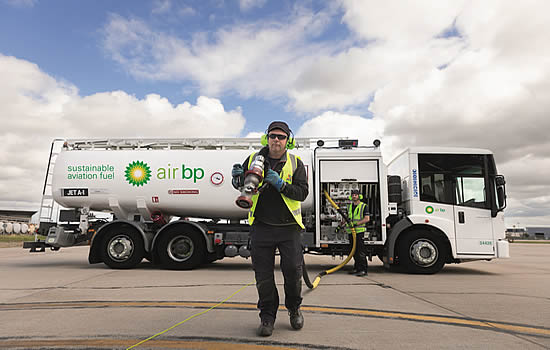The practice of using cover crops is a farming technique that has been around for centuries, but its potential to increase the scale of feedstock for sustainable aviation fuel (SAF) is now starting to be realized.
Take De Broughton, a sixth-generation farmer in Florida. In 2021, she trialled a new crop on her farm - Nuseed Carinata, a green leafy plant with bright yellow flowers that acts as a cover crop.
“I want this land and these resources to be available to my children, and their children, and future generations to come,” she says.
For De and farmers like her, cover crops like carinata help to protect and nourish the soil between growing traditional food crops, like the peanuts and corn that De’s family grows.
In carinata’s case, it’s also a crop from which oil can be sold to bp to generate biofuels, including SAF. That gives carinata, and plants like it, the potential to be one of the largest-scale feedstocks for the production of SAF. In addition, carinata is listed by the International Civil Aviation Organization (ICAO) as a SAF feedstock with a similar greenhouse gas (GHG) footprint as waste and residues, like used cooking oil.
“Cover crops are a win-win - they are helpful to farms and farmers and can also play a role in the energy transition,” says Angela Ruiz Garzon, bp’s global feedstocks programme manager. “Importantly, they can improve soil health and generate oil that can be used to make biofuels without interrupting, or competing with, food crop production, since they can be planted on the same land in between main crop cycles.”
What are cover crops?
A cover crop is a crop grown primarily for the purpose of protecting or improving soil health between periods of main crop production. Cover crops that offer a more sustainable alternative to the use of food crops in biofuel production are those that are grown between main crop cycles and avoid causing direct or indirect land use change by not triggering demand for additional land and maintaining soil carbon.
Cover crops’ potential and benefits
For farmers, cover crops aren’t a new farming method. They have been used for hundreds of years, although the practice declined in the 20th century. That is changing, owing to the recent development of a class of cover crops with multiple benefits - as a sustainable feedstock for aviation fuels and as a way of preventing soil erosion and enriching the soil between food crops.
De’s farm, for example, is this year planning to plant up to 2,500 acres of the cover crop Nuseed Carinata between the main crop harvest and spring planting to regenerate the soil and bring in additional income at a time of year when the land is typically unutilized.
As De’s farm in Florida demonstrates, the potential benefits of cover crops are huge - and not just in the US. In Europe for example, it’s estimated that growing oilseed cover crops on just 10% of available arable land could produce more than five million tonnes of sustainable biofuels, enough to power more than 100,000 transatlantic flights (based on a London - New York flight).1
But the right policy framework is needed to mobilize their potential. If cover crops like carinata or camelina were recognized as an advanced biofuel feedstock under EU rules 2, it could accelerate their adoption.
“Grown with good farming practices and certification programmes, cover crops may be able to generate significant volumes of biofuels. At the same time, they can produce high-protein meal for animal feeds and improve soil health for the benefit of the next main crop to be planted on the land,” says Angela.
“It’s possible that using cover crops to make biofuels may also result in additional retention of carbon in the soil as the plants capture incremental carbon from the atmosphere and store it in the ground in their root systems, which remain there after harvest.”

Photo: bp plc
Fuels of the future
bp is already using the oil made from Nuseed Carinata in the production of biofuels on a small scale.
“Our refineries have worked hard to understand how best to break down the oils processed from seeds like carinata to molecules that are similar to those from fossil fuel, so they can be blended and used in fuel,” says Angela.
Over the past year, bp refineries in Germany and the Netherlands showed that bp can successfully treat carinata oil together with crude oil on the refineries’ existing equipment, known as co-processing. Teams at the two refineries, which mainly refine crude oil, worked together throughout their trials, sharing their experiences and learning from each other as they went.
Those Nuseed Carinata co-processing trials produced a small amount of SAF that can be used by bp customers today.
“We are working to have all the capabilities in place to bring different types of biofuels to the market - from sourcing the feedstock through to bringing it to market.” says Angela.
What’s next for bp and cover crops?
One of the big challenges to producing large volumes of biofuel is the availability of bioenergy feedstocks. In 2022, bp signed a long-term agreement to buy and process Nuseed Carinata, helping bp with access to a consistent, independently certified sustainable supply of bioenergy feedstock.
The team at bp’s Lingen refinery in Germany are already making plans to scale up carinata co-processing volumes, with the next shipment expected from Nuseed in 2024.
Why are some feedstocks better than others?
Not all cover crops are equal when it comes to their use as feedstock for biofuel. The better cover crop is one that improves the soil and that does not create additional demand for land. It would also meet the criteria laid out in the European Union’s Renewable Energy Directive (Article 29).
An example of a cover crop like this is Nuseed Carinata, which is attractive for several reasons, including its involvement with farmers from before the crop even goes in the ground. Nuseed works to:
-
Enable the crop to be sustainably grown, by working in partnership with farmers, from contracting and field selection through to planting, in-season management and harvest.
-
Facilitate independent certification through to storage and delivery.
-
Provide agronomic best practices and analyze satellite images of every field contracted to verify that only existing cropland is used between main crop rotations. This helps to protect forests and food production.
-
Pay farmers to grow Nuseed Carinata under contract and verifies the sustainable farming practices used.
“The oversight Nuseed provides, and the independent certification received throughout the growing and production process, is important for companies like bp. We are looking at ways to procure feedstock that can be tracked to have confidence that the use of agricultural land does not result in additional indirect carbon emissions,” says Angela. bp’s interest in Nuseed Carinata has helped to grow its availability. Since signing the agreement with bp in 2022, Nuseed has accelerated commercial programmes in Argentina, Uruguay and the US and is ramping up new programmes in Brazil, Europe and Australia. |
'bp’s wider transformation is under way. While today we’re mostly in oil and gas, we increased the proportion of our global annual investment that went into our lower carbon & other transition businesses from around 3% in 2019 to around 23% in 2023.' |
1 Estimated using bp assumptions for crop and process yield, broadly consistent with sources such as Clean skies for tomorrow (weforum.org), SAF rules of thumb (icao.int), and using estimates of EU land from Policy implications of multiple concurrent soil erosion processes in European farmland | Nature Sustainability: Fuel burn data from Methodology ICAO Carbon Calculator_v11.1-2018.pdf
2 Annex IX Part A of the EU’s Renewable Energy Directive (RED) lists feedstocks that are considered ‘advanced’ to meet EU transport decarbonisation targets, such as the advanced biofuel sub-target under RED.




